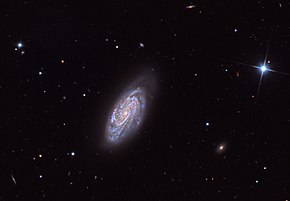Galaxy in the constellation Leo Minor
NGC 3294 is a spiral galaxy in the constellation Leo Minor .[ 5] William Herschel on Mar 17, 1787.[ 9] Leo II Groups , a series of galaxies and galaxy clusters strung out from the right edge of the Virgo Supercluster .[ 10] [ 4] light years and is receding with a heliocentric radial velocity of [ 3] morphological class of NGC 3294 is SA(rs)bc,[ 7] bar (SA), an incomplete inner ring structure (rs), and moderately wound spiral arms (bc).
This galaxy has been host to a pair of supernova events:
References
^ a b Brown, A. G. A. ; et al. (Gaia collaboration) (August 2018). "Gaia Data Release 2: Summary of the contents and survey properties" . Astronomy & Astrophysics 616 . A1. arXiv :1804.09365 Bibcode :2018A&A...616A...1G doi :10.1051/0004-6361/201833051 Gaia DR2 record for this source at VizieR .^ Adelman-McCarthy, J. K.; et al. (2011). "The SDSS Photometric Catalog, Release 8". VizieR On-line Data Catalog: II/306 . Bibcode :2011yCat.2306....0A . ^ a b van Driel, W.; et al. (November 2016). "NIBLES: an H I census of stellar mass selected SDSS galaxies. I. The Nançay H I survey". Astronomy & Astrophysics . 595 : 43. arXiv :1607.02787 Bibcode :2016A&A...595A.118V . doi :10.1051/0004-6361/201528048 . S2CID 118623916 . A118. ^ a b Lianou, S.; et al. (November 2019). "Dust properties and star formation of approximately a thousand local galaxies". Astronomy & Astrophysics . 631 : 19. arXiv :1906.02712 Bibcode :2019A&A...631A..38L . doi :10.1051/0004-6361/201834553 . S2CID 174801441 . A38. ^ a b O'Meara, Steve (2007). Herschel 400 Observing Guide ISBN 9780521858939 ^ a b "NGC 3294" . SIMBAD Centre de données astronomiques de Strasbourg . Retrieved 19 June 2019 .^ a b Herrera-Endoqui, M.; et al. (October 2015). "Catalogue of the morphological features in the Spitzer Survey of Stellar Structure in Galaxies (S4 G)". Astronomy & Astrophysics . 582 : 16. arXiv :1509.05328 Bibcode :2015A&A...582A..86H . doi :10.1051/0004-6361/201526047 . S2CID 118521887 . A86. ^ Skrutskie, Michael F.; et al. (February 1, 2006). "The Two Micron All Sky Survey (2MASS)" . The Astronomical Journal . 131 (2): 1163– 1183. Bibcode :2006AJ....131.1163S . doi :10.1086/498708 ISSN 0004-6256 . S2CID 18913331 . ^ Seligman, Courtney. "New General Catalog Objects: NGC 3250 - 3299" . Celestial Atlas . Retrieved 19 June 2019 . ^ "The Leo III Groups" . Atlas of the Universe . Archived from the original on July 22, 2012. Retrieved 2010-11-27 .^ Perlmutter, S.; et al. (April 1990). Green, D. W. E. (ed.). "Supernova 1990H in NGC 3294". IAU Circular . 4992 (1): 1. Bibcode :1990IAUC.4992....1P . ^ Filippenko, A. V.; Dickinson, M. (April 1990). Green, D. W. E. (ed.). "Supernova 1990H in NGC 3294". IAU Circular . 5003 (2): 2. Bibcode :1990IAUC.5003....2F . ^ Kosai, H.; et al. (February 1992). Green, D. W. E. (ed.). "Supernova 1992G in NGC 3294". IAU Circular . 5452 (1): 1. Bibcode :1992IAUC.5452....1K . ^ Tsvetkov, D. Yu. (May 1994). "Observations of supernovae 1992G, 1992H, and 1993G". Astronomy Letters . 20 (3): 374– 376. Bibcode :1994AstL...20..374T .
External links
